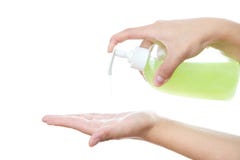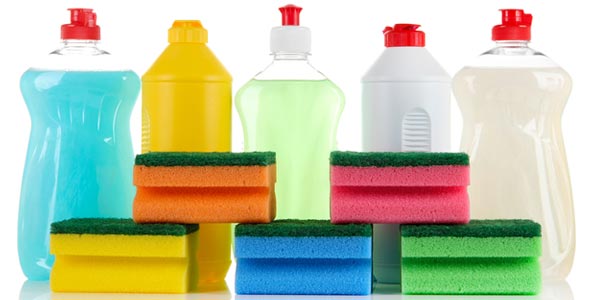 Soap and shower gels are both designed to cleanse the skin, but more often than not that’s where their similarities end. For a long time though, when it came to personal cleanliness, there was only one frontline fighter: bar soap. Of course, bar soap came in many guises - square bars and rounded bars, scented and unscented, clear and opaque -- but its essential look and function went unchanged for hundreds of years. Then other cleansers, both soap and non-soap formulas began to appear. Bar cleansers were joined by liquid products, which were first used primarily for hand washing. The market eventually became flooded with shower gels, also known as body washes, which quickly became a popular alternative to bar soap.
Soap and shower gels are both designed to cleanse the skin, but more often than not that’s where their similarities end. For a long time though, when it came to personal cleanliness, there was only one frontline fighter: bar soap. Of course, bar soap came in many guises - square bars and rounded bars, scented and unscented, clear and opaque -- but its essential look and function went unchanged for hundreds of years. Then other cleansers, both soap and non-soap formulas began to appear. Bar cleansers were joined by liquid products, which were first used primarily for hand washing. The market eventually became flooded with shower gels, also known as body washes, which quickly became a popular alternative to bar soap.If you've spent any time in the skin care aisle at your local store, you know that figuring out which products to buy, soap and non-soap cleansers included, can be a very time-consuming task. So which is better - bar soap or liquid soap? You might be relieved to know that at a very basic level there is no real difference between the two. All types of true soap are composed of the same essential components -- alkali salts of fatty acids and detergent properties. The detergent in soap, which is called a surfactant, allows oil and dirt to mix with and be washed away by water.
Pros and Cons of Bar Soap
Like so many health and beauty products, there are advantages and disadvantages to both bar soap and liquid soap. One of the main complaints about bar soap is that it washes away more than just dirt. Harsh bar soaps can deplete your skin of the moisture it needs to stay healthy. Liquid soaps, on the other hand, often contain moisturisers, but they're also more likely to have fragrances and other additives that may not be the most suitable for sensitive skins.
Washing with contaminated bar soap is unlikely to transfer bacteria
Recent reports of the isolation of microorganisms from used soap bars have raised the concern that bacteria may be transferred from contaminated soap bars during handwashing. Since only one study addressing this question has been published, an additional procedure was developed to test this concern. In our new method pre-washed and softened commercial deodorant soap bars were used. Sixteen panelists were instructed to wash with the inoculated bars using their normal handwashing procedure. After washing, none of the 16 panelists had detectable levels of either test bacterium on their hands.
Thus, the results obtained using our new method were in complete agreement with those obtained with the previously published method even though the two methods differ in a number of procedural aspects. These findings, along with other published reports, show that there is little risk or danger of infection in routine handwashing with previously used soap bars and support the frequent use of soap and water for handwashing to prevent the spread of disease. Bar soap users who are still worried about spreading germs can always make sure that each person has his or her own soap.
Another con of bar soaps is the fact that many have a higher pH level than liquid soaps. Because of this, some bar soaps can be more drying to the skin. Dried-out skin is not only uncomfortable but also heals more slowly when injured. What most liquid soap enthusiasts fail to take into account is that there are many different soaps on the market that have low or neutral pH levels, which are less drying.
 Bar soap enthusiasts are quick to point out that most bar soaps contain glycerine, which is good for people with dermatological problems like eczema. It can even help people who just have dry skin. Also, for people who are allergic to fragrances, bar soaps can be the most convenient option; there are many bar soaps on the market that are fragrance-free. Fragrance-free liquid soaps, on the other hand, are a little harder to find.
Bar soap enthusiasts are quick to point out that most bar soaps contain glycerine, which is good for people with dermatological problems like eczema. It can even help people who just have dry skin. Also, for people who are allergic to fragrances, bar soaps can be the most convenient option; there are many bar soaps on the market that are fragrance-free. Fragrance-free liquid soaps, on the other hand, are a little harder to find.Pros and Cons of Liquid Soap
As with bar soaps, there are also pros and cons to using liquid soaps. One strike against liquid soap is waste. With bar soaps, it's fairly easy to know when you have acquired enough on your washcloth or loofah to get the job done. Because liquid soaps usually come in pump-action or easy-to-squeeze bottles, overuse is common. Factor in the higher cost for liquid soaps, and you end up with a lot of waste that you don't typically get with bar soaps.
If you're a body wash enthusiast, though, don't give up hope. There are some pros to using liquid soaps. Unlike their bar-shaped counterparts, you never get that mushy pile of soap scum that often occurs when bar soap is left in standing water, although you can mitigate that problem with different soap saver products on the market. And while it's easy to lose bar soap down the drain, you're less likely to lose a bottle of liquid soap. In addition, liquid soap tends to create a richer lather, which many people prefer over thinner bar soap lathers.
 Strong bar soaps, especially those designed to act as deodorants, can be too harsh for some people, stripping away important oils and leaving the skin irritated. Many liquid soaps and body washes contain moisturisers, however, and they tend to be milder than bar soaps. Women can benefit most from liquid soaps containing moisturisers - their skin is typically more sensitive than men's, and using a deodorant bar soap can leave dry spots and cause itchiness.
Strong bar soaps, especially those designed to act as deodorants, can be too harsh for some people, stripping away important oils and leaving the skin irritated. Many liquid soaps and body washes contain moisturisers, however, and they tend to be milder than bar soaps. Women can benefit most from liquid soaps containing moisturisers - their skin is typically more sensitive than men's, and using a deodorant bar soap can leave dry spots and cause itchiness.The bottom line is that using liquid soap or bar soap is a personal choice. More than the method of delivery, the most important thing for you to be aware of is how you react to certain additives, such as fragrances and moisturisers. Whichever one you choose, note that the U.S. Food and Drug Administration (FDA) ruled in 2016 that the benefits of using antibacterial soap haven't been proven and that the antibacterial active ingredients triclosan and triclocarban also have not been proven to be safe for daily use.